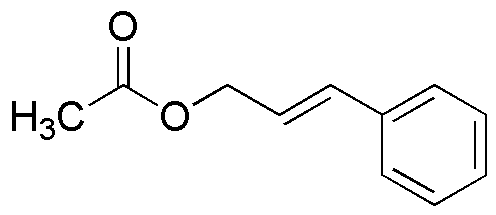Cinnamyl acetate is widely utilized in research focused on:
- Fragrance Industry: This compound is a key ingredient in perfumes and scented products, providing a sweet, warm, and spicy aroma that enhances the overall fragrance profile.
- Flavoring Agent: Commonly used in food products, it adds a pleasant cinnamon-like flavor to candies, baked goods, and beverages, making it popular in the culinary industry.
- Cosmetics: Cinnamyl acetate is incorporated into various cosmetic formulations, such as lotions and creams, due to its aromatic properties and skin-friendly nature, appealing to beauty product manufacturers.
- Pharmaceuticals: In medicinal applications, it can serve as a flavoring agent in syrups and other formulations, improving patient compliance by masking unpleasant tastes.
- Research Applications: It is used in organic synthesis and as a model compound in studies related to esters and aromatic compounds, aiding researchers in understanding chemical behaviors and reactions.
General Information
Properties
Safety and Regulations
Applications
Cinnamyl acetate is widely utilized in research focused on:
- Fragrance Industry: This compound is a key ingredient in perfumes and scented products, providing a sweet, warm, and spicy aroma that enhances the overall fragrance profile.
- Flavoring Agent: Commonly used in food products, it adds a pleasant cinnamon-like flavor to candies, baked goods, and beverages, making it popular in the culinary industry.
- Cosmetics: Cinnamyl acetate is incorporated into various cosmetic formulations, such as lotions and creams, due to its aromatic properties and skin-friendly nature, appealing to beauty product manufacturers.
- Pharmaceuticals: In medicinal applications, it can serve as a flavoring agent in syrups and other formulations, improving patient compliance by masking unpleasant tastes.
- Research Applications: It is used in organic synthesis and as a model compound in studies related to esters and aromatic compounds, aiding researchers in understanding chemical behaviors and reactions.
Documents
Safety Data Sheets (SDS)
The SDS provides comprehensive safety information on handling, storage, and disposal of the product.
Product Specification (PS)
The PS provides a comprehensive breakdown of the product’s properties, including chemical composition, physical state, purity, and storage requirements. It also details acceptable quality ranges and the product's intended applications.
Certificates of Analysis (COA)
Search for Certificates of Analysis (COA) by entering the products Lot Number. Lot and Batch Numbers can be found on a product’s label following the words ‘Lot’ or ‘Batch’.
*Catalog Number
*Lot Number
Certificates Of Origin (COO)
This COO confirms the country where the product was manufactured, and also details the materials and components used in it and whether it is derived from natural, synthetic, or other specific sources. This certificate may be required for customs, trade, and regulatory compliance.
*Catalog Number
*Lot Number
Safety Data Sheets (SDS)
The SDS provides comprehensive safety information on handling, storage, and disposal of the product.
DownloadProduct Specification (PS)
The PS provides a comprehensive breakdown of the product’s properties, including chemical composition, physical state, purity, and storage requirements. It also details acceptable quality ranges and the product's intended applications.
DownloadCertificates of Analysis (COA)
Search for Certificates of Analysis (COA) by entering the products Lot Number. Lot and Batch Numbers can be found on a product’s label following the words ‘Lot’ or ‘Batch’.
*Catalog Number
*Lot Number
Certificates Of Origin (COO)
This COO confirms the country where the product was manufactured, and also details the materials and components used in it and whether it is derived from natural, synthetic, or other specific sources. This certificate may be required for customs, trade, and regulatory compliance.

